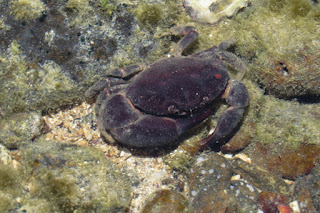At Mission Beach are some unique rocky reefs of volcanic origin.
Local volcanoes produced a very fluid lava that spread across the
landscape in long streams. One of these streams created Clump Point,
a finger of land which juts almost a kilometre into the sea. On
aerial photos, other lava flows are easily identified including a few
that are partially or fully submerged. Old lava flows are also hidden
two metres below the tourist trampled white sand of Mission Beach.
 |
| Pelicans resting on a lava flow, a few hundred metres from shore |
This post looks at a
pillow lava reef which was five kilometres out to sea. This rocky
reef probably breaks the surface far more than it is submerged. There
is no beach and no terrestrial vegetation, only a hectare sized patch
of black rocks. It is very hot and not very interesting unless you
are a biologist. Even then, you want to study this place properly
the first time so that you do not have to come back. Surrounding the
reef is a sandy seabed and the margins of the reef have a hedge of
sargassum. Coral is not to be seen.
 |
| This lava reef is five kilometres from shore |
 |
| The edge of the old lava flow has sargassum and is surrounded by a sandy bottom |
When you stand and
stare long enough, you realise that this reef has a rich diversity of
algal turf grazers. Fish, crabs and snapping shrimp battle for
territories of turf. Blennies would attack and drive off much larger
crabs. Crabs with heavy nippers would become frustrated with trying
to clip the turf and would push their faces into the turf to chew it
off directly. Even snapping shrimps would graze the turf using their
larger nippers like shears with long, thin, lightly built arms
darting over the surface picking up bits and pieces.
 |
| This snapping shrimp was cropping algal turf with the big nipper and picking at it with a skinny green nipper |
 |
| A common hairy crab - Pilumnus vespertilio |
 |
| A swimming crab grazing with its mouth |
 |
| Another type of hairy crab grazing with its nippers |
Large, heavily built
crabs consume molluscs, both oysters and many gastropods that would
normally assume the grazing role. Oysters were limited to exposed
edges where water flow would be better and predator access more
limited. Only a few neritas and cowries were on the basalt reef.
 |
| A black finger crab is able to crush strong sea shells |
On a nearby reef trochus shells were present. The nearby reef
was a different geology, possibly a contact zone rock which was
melted by the lava flow, then re-solidified. Corals also performed
much better on this substrate.
 |
| Trochus shell in pocket in rocky reef |
 |
| The underside of the same shell |
 |
| A rocky reef that is probably contact zone rock, rather than basalt. |
Volcanic features
such as dykes and cliffs of solidified ash are present on nearby
islands and on the mainland. At the bottom of one of these cliffs was
a rock shelf which was only just inundated at high tide. On this
shelf was a very shallow pool and a few rocks, fallen from the cliff.
It was a particularly nasty place, intensely hot and saline. Yet when
I looked, most of the stones were surrounded by a wide black halo. I
also had the feeling that something was hiding behind one of the
stones. I walked around the stone about five times and didn’t see
anything but could hear frantic splashing. The only way to find out
was to lift and remove the rock. A few crabs ran off but there were
several large gobies stranded in a film of water too shallow for them
to swim in. Apparently this species chooses to live in this habitat,
a tiny area of the very worst aquatic habitat I could find. I love
finding exotic creatures in places were nothing should be able to
survive.
 |
| Dusky Frill Gobies in very shallow water on a rock platform |
 |
| The rock I lifted to see the fish |
 |
| Wider view of platform of compressed volcanic ash |













